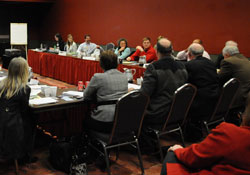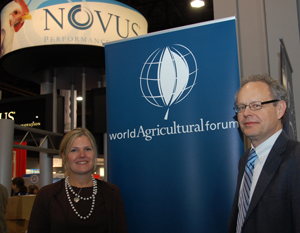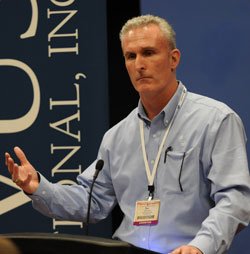Soybeans are better than ever for the environment, which makes soy-based products greener than ever.
 That’s the findings of a new peer-reviewed life cycle profile just released by the United Soybean Board (USB) that documents multiple energy and environmental benefits of U.S. soybean farming and processing.
That’s the findings of a new peer-reviewed life cycle profile just released by the United Soybean Board (USB) that documents multiple energy and environmental benefits of U.S. soybean farming and processing.
“This profile is the first comprehensive life cycle study covering U.S. soybean production through four major biobased products,” said Arkansas soybean farmer John Cooper, a USB Director and Member of the USB Domestic Marketing Committee. “U.S. soy already delivers environmental and energy benefits. It’s exciting to see the trends point to even more in the future.”
A key objective was to update life cycle inventory (LCI) databases for soybean production and processing as well as conversion into four key soy-derived feedstocks (methyl soyate, soy lube base stock, soy polyol, and soy resin) used in fuel and industrial products. Its cradle-to-gate scope begins with soybean farming (the cradle) and goes through processing of products (the gate).
Among the study’s key findings are that soybean production results in significant greenhouse gas reductions and that soybean yields are 12 percent higher than 10 years ago and should increase 40 percent over the next decade.
The updated data show approximately 20% less direct energy used in soybean farming due to reduced diesel and gasoline usageand soybean processing facilities reduced their energy consumption by 45% compared to 1998 data.



 Much of the work done at the Cattle Industry Convention is in committees. These meetings are open and as I’ve found over the years, a great learning experience to attend. I did a walk around during the main committee time as part of my work for the
Much of the work done at the Cattle Industry Convention is in committees. These meetings are open and as I’ve found over the years, a great learning experience to attend. I did a walk around during the main committee time as part of my work for the  You get to meet a lot of wonderful people in a media room, including the media. At the Cattle Industry Convention one of the interesting people I met was Linda Brake. She was named the 2009 Outstanding CattleWoman of the Year by the American National CattleWomen. Linda is from Arizona and seemed a little overwhelmed by the honor. The award is sponsored by Land O’ Lakes Purina Mills LLC.
You get to meet a lot of wonderful people in a media room, including the media. At the Cattle Industry Convention one of the interesting people I met was Linda Brake. She was named the 2009 Outstanding CattleWoman of the Year by the American National CattleWomen. Linda is from Arizona and seemed a little overwhelmed by the honor. The award is sponsored by Land O’ Lakes Purina Mills LLC. During the International Poultry Expo/International Feed Expo in Atlanta last week,
During the International Poultry Expo/International Feed Expo in Atlanta last week, 
 Starting March 1, the
Starting March 1, the 
 C. Larry Pope, president and CEO of Smithfield Foods Inc., was keynote speaker for the two day summit and his main message was that the animal agriculture industry, both processors and farmers, need to listen to and engage the people and groups who are attacking them. He said that it is important to talk with these individuals and groups to show them the industry’s side of the story. “We need to educate all of the groups that challenge our practices,” Pope said.
C. Larry Pope, president and CEO of Smithfield Foods Inc., was keynote speaker for the two day summit and his main message was that the animal agriculture industry, both processors and farmers, need to listen to and engage the people and groups who are attacking them. He said that it is important to talk with these individuals and groups to show them the industry’s side of the story. “We need to educate all of the groups that challenge our practices,” Pope said. Also on the program was Christian Richter of The Policy Group, who discussed the regulatory mood in Washington when it comes to animal agriculture. “Hyper command and control mode is coming back at EPA,” said Richter. “The current administration is shifting personnel from cooperative voluntary programs to enforcement programs.” He notes this represents a major shift in focus from the Bush administration which advocated the role of non-government drivers in prompting more voluntary action on the part of corporations towards sustainable practices.
Also on the program was Christian Richter of The Policy Group, who discussed the regulatory mood in Washington when it comes to animal agriculture. “Hyper command and control mode is coming back at EPA,” said Richter. “The current administration is shifting personnel from cooperative voluntary programs to enforcement programs.” He notes this represents a major shift in focus from the Bush administration which advocated the role of non-government drivers in prompting more voluntary action on the part of corporations towards sustainable practices. When it comes to communicating NOVUS International’s commitment to the beef industry Dan is the man. He’s Dan Meagher, VIce President, Sales, Americas. He was on hand at the Cattle Industry Convention to help spread the word about the company name and products for the beef industry.
When it comes to communicating NOVUS International’s commitment to the beef industry Dan is the man. He’s Dan Meagher, VIce President, Sales, Americas. He was on hand at the Cattle Industry Convention to help spread the word about the company name and products for the beef industry.